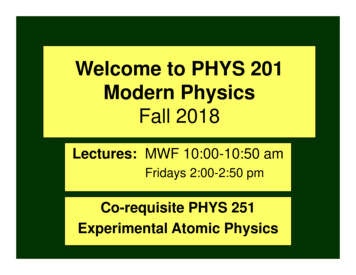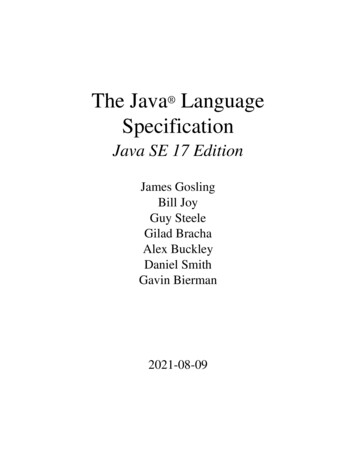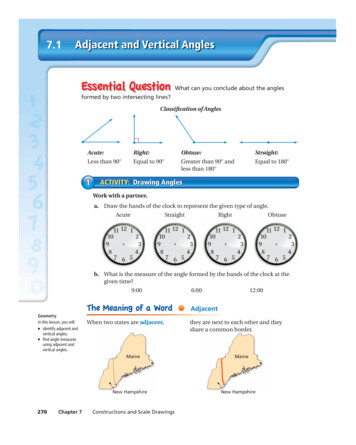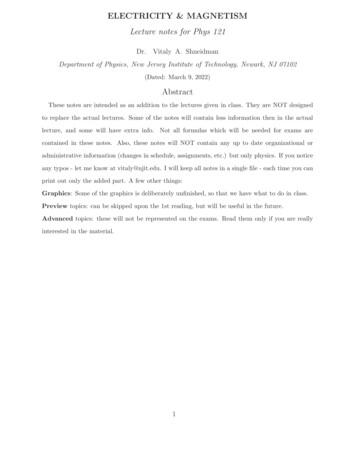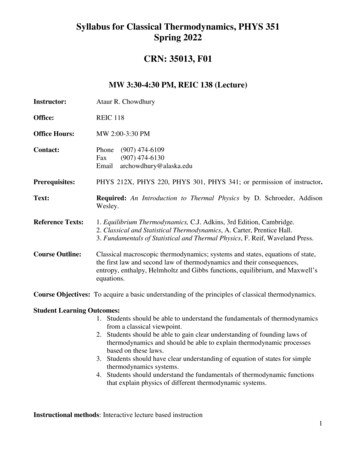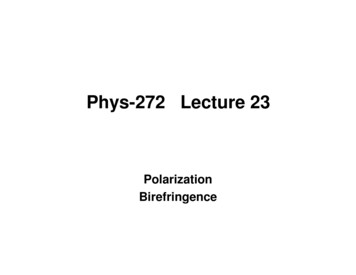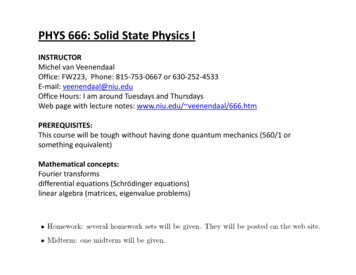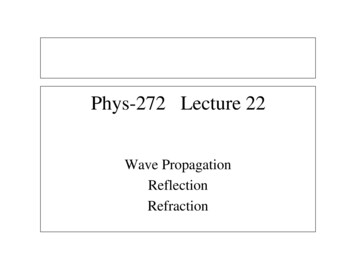
Transcription
Phys-272 Lecture 22Wave PropagationReflectionRefraction
Phys-272 Lecture 22ReflectionRefractionHuygen’s PrincipleDispersionLight ScatteringPolarization
θi θrn1 sin θ1 n2 sin θ 2
Index of Refraction (n) Speed of light, c, in vacuum is 3x108 m/s (2.99792458x108 m/s) Speed of light, v, in a medium can be lower i.e. v c. index of refraction, n c/v frequency, f, is unmodified as v f l, wavelength, l, depends on medium, λ vT v/f c/nf λ0/n In some media, n, depends on f, this is called dispersion.
Waves, wavefronts, raysPlane waves moving in x directionrE ( x, y, z , t ) E0 yˆ cos(kx ωt )rB( x, y, z , t ) B0 zˆ cos(kx ωt )Wavefront is a surfaceof constant phaseE field wavefront (y-z plane surface of constant phase)yRay propagationzx
Huygen’s Principle Huygen’s principle; a wave front can be a source of secondarywavelets that spread out in all directions at the speed of propagationin the medium. The envelope of leading edges forms a wave front. This principle was stated by Huygen in 1678, it can be derivedfrom Maxwell’s eqns. It is a geometrical description of raypropagation.vtPlane wave example;Secondary wavelets createanother wave front (plane)
Reflection from Huygen’s PrincipleConsider wave fronts, separated by vt, the incident wave fronts incontact with the surface will create a wavelets according to Huygen’sPrinciple and leds to another “reflected” wave front. Result is qi qrreflected wave frontIncident wave frontvtqrvtvtvtqiqi qrReflection Lawray diagramqiqr
The same effect can be seen with waterwaves in a ripple tank
Refraction from Huygen’s PrincipleNow the speed changes, from medium a to medium b, so theSpeed may change and the wavefront spacing differs.L sinqa vat ct/navatL sinqb vbt ct/nbvatMedium a, va c/naMedium b,vb c/nbqbvbtLvbtLqaevaWtnfrotnorefvaWna sinqa nb sinqbsame thing happens tomarching soldiersSnell’s LawWhat happens to the frequency ? Nothing
ideIncnormalSnell’s Law (law of refraction)yranteavWqaMedium a, va c/naqaqbqbaed rtnorefvaWdetacrfeRractRefMedium b, vb c/nbtnfroyna sinqa nb sinqbSnell’s LawAngles aredefinedrelative to thenormal to plane
Clicker question2) A ray of light passes from air intowater with an angle of incidence of30o. Which of the following quantitiesdoes not change as the light enters thewater. .a) Wavelengthb) frequencyc) speed of propagationd) direction of propagation.
MaterialIndexVacuum1.00000Air at STP1.00029Ice1.31Water at 20 C1.33Acetone1.36Ethyl alcohol1.36Sugar solution(30%)1.38FluoriteFused quartzGlycerineSugar solution (80%)Typical crown glassCrown glassesSpectacle crown, C-1Sodium ices of RefractionPolystyreneCarbon disulfideFlint glassesHeavy flint glassExtra dense flint, EDF3Methylene senic trisulfide glass1.771.71.841.821.982.04Diamond2.417Rare earth flintLanthanum flintHigh Index n Lots of TIR
Clicker question Which of the following ray diagrams could represent the passage of light from airthrough glass and back to air?(a)(nair 1 and nglass 1.5)(b)(c)airairairglassglassglassairairair
Clicker question Which of the following ray diagrams could represent the passage of light from airthrough glass and back to air? (nair 1 and nglass 1.5)(a)airglassairq1(b)q2(c)airairglassglassairair The behavior of these rays is determined from Snell’s Law:n1 sin θ1 n2 sin θ 2 Since n(glass) n(air), sinq (glass) sinq (air) . Therefore, moving from air to glass, ray will bend toward normal. this eliminates (a). Moving from glass to air, ray will bend away from normal. this eliminates (c). As a matter of fact, the final angle in air must be equal to the initialangle in air!!
EXAMPLE, from air into glass;Suppose we have light in air (n 1)incidence on glass (n 1.55) at anangle qa 45 deg. What is the angleof the refracted light, qb?nair sin θ a n glass sin θ b(1) sin (45 ) (1.55) sin θ bsin θ b ( )(1) sin (45 )θ b 27 1.551 1.55 2qaqb
EXAMPLE, from glass into air;Suppose we have light in glass (n 1.55)incident into air at an angle qa 30 deg.What is the angle of the refracted light, qb?n glass sin θ a nair sin θ b(1.55) sin (30 ) (1) sin θ b1.55sin θ b (1.55) sin (30 ) 2θ b 51 qaqb
Suppose you are stranded on a tropical island with no food.You see a fish in the water. Where should you aim your spearto hit the fish?ANSWER; do not aim directly at the apparent position ofthe fish. (Your spear will miss). Aim at the inside of the fish.
Suppose in the previous question instead of a spear youhad a high power laser to simultaneously kill and cook thefish (in the water). Where should you aim the laser?ANSWER; aim directly at apparent fish position as the laserbeam will refract to the correct fish position.
Total Internal Reflection– Consider light moving from glass (n1 1.5) to air(n2 1.0)incidentreflectedsin θ 2 n1rayray 1θ 2 θ1q1 qrn1sin θ1 n2GLASSn2q2refractedrayAIRI.e., light is bent away from the normal.as q1 gets bigger, q2 gets bigger, but q2can never get bigger than 90 !!In general, if sin q1 (n2 / n1), we have NO refracted ray;we have TOTAL INTERNAL REFLECTION.For example, light in water which is incident on an air surfacewith angle q1 qc sin-1(1.0/1.33) 48.8 will be totally reflected.This property is the basis for the optical fiber communication.
Total Internal Reflection of a Laser BeamMaterial: PMMAEndoscope usedby physicians tolook inside body.
Clicker questionI) The path of light is bent as it passes from medium1 to medium 2. Compare the indexes of refraction inthe two mediums.a) n1 n2b) n1 n2Snell’s Law: n1sinq1 n2sinq2Here, q2 q1 implies n2 n1c) n1 n2II) A light ray travels in a medium with n1 andcompletely reflects from the surface of amedium with n2. The critical angle depends on:a) n1 onlyb) n2 onlyc) n1 and n2Critical angle occurs when q2 90oTherefore, sinqcritical n2/n1
Clicker question on Critical Angle An optical fiber issurrounded by anotherdielectric. In case I this iswater, with an index ofrefraction of 1.33, while incase II this is air with anindex of refraction of 1.00.Compare the critical anglesfor total internal reflectionin these two casesa) qcI qcIIb) qcI qcIIc) qcI qcIIwater n 1.33Case Iqcglass n 1.5water n 1.33Case IIair n 1.00qcglass n 1.5air n 1.00
Clicker question on Critical Angle An optical fiber issurrounded by anotherdielectric. In case I this iswater, with an index ofrefraction of 1.33, while incase II this is air with anindex of refraction of 1.00.qcglass n 1.5water n 1.33Case IICompare the critical anglesfor total internal reflectionin these two casesa) qcI qcIIwater n 1.33Case Iair n 1.00qcglass n 1.5air n 1.00n2b) qcI qcIIn1c) qcI qcIISince n1 n2 TIR will occur for q critical angle.Snell’s law says sinqc n2/n1.n1 n2If n2 1.0, then qc is as small as it can be.So qcI qcII .
Total Internal ReflectionTotal internal reflection occurs when q qc and provides 100%reflection. This has better efficiency than silvered mirror.Examples of devices using Critical Angle Prism Binoculars Fiber OpticsFiber optics is extremely important for high speedInternet and digital data transfer at long distances.Many companies (Lucent, Oceanic Cable ) havelaid fiber over long distances to provide internet service.
Dispersion: n n(w)The index of refraction depends onfrequency, due to the presence ofresonant transition lines.For example, ultraviolet absorptionbands in glass cause a rising indexof refraction in the visible, i.e.,n(higher w) n(lower w):Index of refractionnred 1.52nblue 1.531.54ultravioletabsorptionbands1.52white lightprism1.50frequencySplit into Colors
Rainbows (how theyform)
RainbowsHence we also see a faintsecondary rainbow
A meter stick lies at the bottom of arectangular water tank of height 50cm.You look into the tank at an angle of45o relative to vertical along a line thatskims the top edge of the tank.45onwater 1.3350 cmWhat is the smallest number on theruler that you can see?0Conceptual Analysis:- Light is refracted at the surface of the waterStrategy:- Figure out the angle of refraction in the waterand extrapolate this to the bottom of the tank.20406080100
A meter stick lies at the bottom of arectangular water tank of height 50cm.You look into the tank at an angle of45o relative to vertical along a line thatskims the top edge of the tank.45onwater 1.33qR50 cm020If you shine a laser into the tank at an angle of 45o, what is therefracted angle qR in the water ?A) qR 28.3oB) qR 32.1oC) qR 38.7onairsin(45) nwatersin(qR)sin(qR) nairsin(45)/nwater 0.532qR sin-1(0.532) 32.1o406080100
A meter stick lies at the bottom of arectangular water tank of height 50cm.You look into the tank at an angle of45o relative to vertical along a line thatskims the top edge of the tank.45onwater 1.33qR50 cm020406080100qR 32.1oWhat number on the ruler does the laser beam hit ?A) 31.4 cmB) 37.6 cmC) 44.1 cm
A meter stick lies at the bottom of arectangular water tank of height 50cm.You look into the tank at an angle of45o relative to vertical along a line thatskims the top edge of the tank.45onwater 1.33qR50 cm020dWhat number on the ruler does the laser beam hit ?A) 31.4 cmB) 37.6 cmC) 44.1 cmtan(qR) d/50d tan(32.1) x 50cm 31.4cm406080100qR 32.1o
A meter stick lies at the bottom of arectangular water tank of height 50cm.You look into the tank at an angle of45o relative to vertical along a line thatskims the top edge of the tank.45onwater 1.3350 cmWhat is the smallest number on theruler that you can see?02040If the tank were half full of water, would the laser hit a bigger or asmaller number than it did when the tank was full of water ?A) biggerB) smallerC) The same number6080100
45o45oqR45o50 cm50 cmd 31.4 cm02040d 50 cm608010002045o50 cmqR020d 40.7 cm4025 cm (31.4 / 2) cm6080100406080100
For example, light in water which is incident on an air surface with angle q1 qc sin-1(1.0/1.33) 48.8 will be totally reflected. This property is the basis for the optical fiber communication. incident ray reflected ray refracted ray q2 q1 qr GLASS n AIR 2 n1 1 sin sin 2 1 1 2 n n


